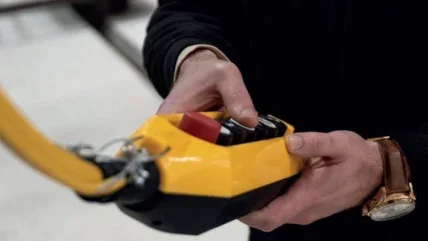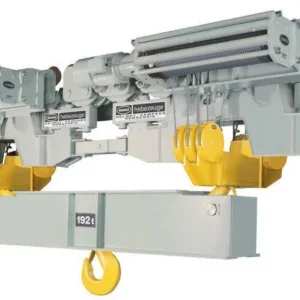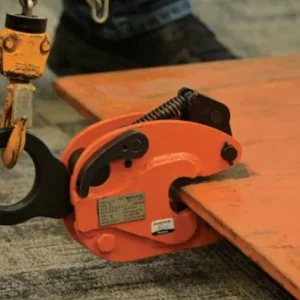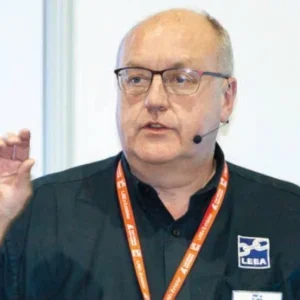
Across Europe, nations are rethinking their nuclear strategies. In May 2025, Belgium officially repealed its 2003 law that mandated a gradual nuclear phaseout, a symbolic yet concrete example of the policy reversals happening across the EU. Countries including France, Sweden and the Netherlands are expanding nuclear programmes. Even the UK – long seen as a cautiously supportive outlier – has reaffirmed its commitment to nuclear as a cornerstone of its future energy strategy.
“It’s actually very exciting overall. So, what we’re seeing is a growing interest from a large number of EU countries towards nuclear,” says Emmanuel Brutin, director general at nucleareurope, which represents the nuclear sector to European institutions. “When you look at the landscape today, we have about 12 EU member states that operate nuclear facilities. This amounts just to 100GW of nuclear electricity production capacity across the EU, which is about 24% of the EU’s electricity.”

“Life is a bit easier now,” adds Nathan Paterson, senior programme leader for supply chain activities at the World Nuclear Association, which is uniquely placed to facilitate growth across the sector by bringing together various players that represent the industry to discuss common challenges, collaborate and develop best practices. “There were a lot more anti-nuclear barriers for progressing certain policies for industrial development across multiple countries in Europe [three years ago]. There’s a lot more togetherness now.”
Just a few years ago, Paterson explains, there were specific policies that were trying to shift funding towards decommissioning nuclear plants and waste management, but recently there has been a lot more focus on building new plants as concerns for energy security rise alongside demand for ecofriendly energy. This requires a large amount of investment, however, as according to the European Commission, nuclear energy will require investment of €241bn until 2050 for extensions of existing reactors and new builds.
“New nuclear facilities have a significant upfront cost, so these are very big investments,” explains Brutin. “However, extending the lifetime of existing nuclear power plants is always the best investment you can do to maintain energy costs at a reasonable level.”
Brutin points to Belgium’s recent shift towards nuclear energy; nuclear power makes up a large share of the country’s electricity mix. While phasing out nuclear power would pose a sustainability issue, as the energy would likely be replaced by electricity produced out of gas, he explains, it would also affect affordability.
A shifting landscape
It’s clear that Europe’s energy strategy is undergoing a profound shift. After years of regulatory and political hesitation, the war in Ukraine and rising energy prices have refocused attention on energy independence and resilience. Nuclear energy – responsible for around 40% of the EU’s carbon-free electricity – has, therefore, re-emerged as a vital player in the bloc’s future energy mix.

Belgium’s recent U-turn joins similar moves seen across Europe, in countries like France, who have made plans to build six new EPR2 reactors, and Sweden, where lawmakers have lifted restrictions on nuclear expansion. “What we also see is strong interest in nuclear energy in countries that do not have nuclear power today. For instance, Poland is currently in the process of launching their first nuclear reactor and there are similar discussions happening in Italy,” says Brutin. “It is a very exciting time for the sector. I think there’s a big realisation from policymakers across the EU and even beyond that, actually, nuclear is needed if we’re serious about achieving our net-zero ambition.”
Paterson agrees, adding, “There are countries like Denmark who have mostly been against nuclear that are now a bit more open to the concept. The Nordics have also been good at backing what could be done for nuclear too, but in Sweden and Finland I can see a lot of potential happening there in the next five to 10 years.”
New developments reflect this optimism. In the UK, nuclear energy is now seen as essential to meeting net-zero goals and ensuring longterm energy stability. The government has backed new-build projects such as Sizewell C and has launched Great British Nuclear (GBN), an initiative aimed at streamlining project delivery and encouraging private investment. In addition to Sizewell C in the UK, European nations are embracing innovation through waste management, SMRs and advanced reactor designs.
In Finland, they are in the process of opening Onkalo, a permanent storage site for nuclear waste located near the Olkiluoto Nuclear Power Plant. “This is interesting – a world first actually,” says Brutin. “One of the key questions related to nuclear is ‘what happens with the waste in the long term?’” Finland’s “ambitious” answer to this is the world’s first underground storage site for nuclear waste, which is 433m below sea level and aims to store waste for 100,000 years. “It was really a fantastic thing to visit and proves that in Europe we’re able to do fantastic things.”
Something that’s currently being developed is small nuclear reactors (SMRs), which would serve a more local purpose, Brutin explains, such as providing heating or electricity to a factory or district. The Oklo–Korea Hydro and Nuclear Power (KHNP) partnership, announced in May, highlights this international momentum around compact, efficient reactor designs. In the UK, two new Generic Design Assessments (GDAs) have started on the Holtec International SMR-300 and GE Hitachi BWRX-300 designs, alongside the progress of the Rolls-Royce Small Modular Reactor (SMR) GDA through Step 2 of the regulatory assessment.
Limited lifetimes
Despite its low-carbon credentials and promise of long-term stability, nuclear energy faces significant hurdles. Across the EU, cost overruns, long construction timelines, and regulatory hurdles have hampered progress. For example, Finland’s Olkiluoto 3 reactor was delayed by more than a decade and significantly over budget.
In the UK, delays at Hinkley Point C have raised concerns over rising costs, safety and potential environmental impact. Meanwhile, the legacy of older plants brings logistical and financial challenges around decommissioning, where the hoisting industry has an increasingly central role. Companies like NKM Noell, which provides advanced hoist systems for nuclear environments, have long operated at the forefront of this industry. Its systems are designed to function reliably in harsh conditions, offering remote operation, enhanced safety protocols, and ultra-precise handling capabilities.

There are multiple plants across Europe that require refurbishment, explains Paterson. Components, such as the reactor pressure vessel head, which creates the pressure seal, is replaced periodically. “Outside the nuclear islands, there will be multiple things happening in the turbine island, which would require a lot of complex lifting during long-term operation refurbishment works.”
As Brutin emphasises, a lot of time and investment goes into building these plants, so it makes sense to extend the lifetime of a plant where possible. “At the beginning when they were designed, we saw they would operate for 40 years. Now, the lifetime for most power plants is being extended to 60 years. There are already discussions about maintaining them for up to 80 years.”
However, once the nuclear plants lifetime is reached, it is important to start the decommissioning process, Brutin continues. “This in itself is going to be a time-consuming process because you basically need to wait for the radiation levels to go down before you decommission some of the parts.”
In the past, there has been a push for decommissioning nuclear plants, which is essential to ensure the long-term protection of the environment and people. The UK is currently decommissioning several nuclear sites, including Dungeness A and Hunterston B, under the stewardship of the Nuclear Decommissioning Authority (NDA). These complex processes involve dismantling highrisk infrastructure, handling radioactive waste and managing vast volumes of heavy, ageing equipment. “It’s a significant industrial operation to decommission power plants,” explains Brutin. According to the Office for Nuclear Regulation, Hunterston B is more than 50% defuelled with reactor 3 completely empty in September 2023 and reactor 4 under way, and Hinkley Point B station is approaching the 50% mark too.
Precision lifting solutions are essential in this space. From shielded cranes capable of operating in radiation-heavy zones to modular hoists used in controlled demolitions, the hoisting industry provides the critical equipment and technical support necessary for safe and efficient deconstruction.
Safety first
Public opinion towards nuclear energy has traditionally been mixed across Europe and the UK. Incidents such as the Fukushima Daiichi accident in Japan raised concerns about safety and significantly influenced public perception on nuclear power. “It is important to keep in mind that we’ve never had in Western Europe a major nuclear accident,” says Brutin. “In the nuclear industry, safety is what we’re really all about. We’re extremely regulated by national nuclear safety authorities and there is a huge amount of work being done in terms of sharing information and peer review between nuclear plants.

“But that’s definitely an area where we cannot be complacent and it’s really embedded into the culture of our sector,” stresses Brutin. While environmental groups continue to express concern over waste management and safety, broader sentiment appears to be warming, particularly in the context of climate change and high energy costs.
“From my recent trips in Poland, Hungary and Finland, in these three countries there’s a record level of support for nuclear. If I’m not mistaken, in Poland they told me about 90% were in favour of nuclear, and when I was in Finland last week, it was only 6% against,” explains Brutin. “I think people are really realising how important it is.”
Nuclear energy not only provides energy security, but also carbon-free energy. Over 80% of energy is provided through the burning of oil, gas and coal, which hasn’t changed since 1990, according to the World Nuclear Association. The emissions from these fuels are complicit in climate change and damage to the environment, which has presented a unique challenge of reducing these emissions while meeting the growing demands for energy globally. There has been a large push towards renewable energy in attempts to meet these demands and cut emissions. However, explains Brutin, “renewable sources are by definition variable because they depend on the weather. The very strong benefit of nuclear is that we produce constant electricity, which is very important both for those managing the energy grid because it means they have [constant] access to this.”
As one of the few decarbonised sources to provide a base load of energy to the grid, it is well positioned to work with renewables and manage the variable nature of the renewable energy, he continues. “In countries which do not have nuclear energy or have been shutting down the production like Germany, it’s important to have this recognition that nuclear energy provides the benefits to the entire European system as a whole,” says Brutin. “With the example of Germany, we do not expect them to reopen the nuclear power plants but in the meantime, they’re actually importing quite a lot of electricity, which is generated in France by nuclear power plants.
“No one can do this alone. Not one country and not even one region. That’s why there’s a lot of international collaboration going on as well,” adds Paterson. In order to be truly sustainable, however, countries shouldn’t just rely on the clean energy the plants will produce once built. The construction, maintenance and decommissioning of nuclear plants require various materials, equipment and machinery, all of which require energy too. Sustainability within nuclear lifting operations, therefore, includes reducing the carbon footprint of equipment, reusing materials in decommissioning and implementing energyefficient machinery.
Many hoist manufacturers are now adopting life cycle assessments (LCAs) to improve the environmental profile of their products. “We need to be thinking about all the things that were not always at the forefront in the past, so how to make the whole construction process a bit more sustainable, how we can be using less energy to do the construction itself, producing less emissions by some actual infrastructure being more electrically different in the construction fields,” Paterson continues.
Lifting for nuclear?
The revival for nuclear power has had major implications for the hoisting and lifting industry, which plays a critical but often underappreciated role in nuclear infrastructure, from plant construction and maintenance to decommissioning and modernisation.
In both the construction and decommissioning of nuclear facilities, hoisting solutions are indispensable. Tasks include installing reactor vessels, handling radioactive waste, moving massive concrete segments and servicing turbine systems.
Typically, these applications require custom-built or heavily modified cranes. Overhead cranes with precise load control, shielded hoists for radiological safety and modular gantry systems are among the most commonly deployed tools. Automation and remote operation are becoming increasingly vital, especially for working and staying safe in high-radiation environments.
“The industry is going to grow by about five times as many projects as there is now in the next five to 10 years. Do we have enough providers of services like hoists and cranes? I believe the answer is yes if all the parts of the value chain are engaged early to have sight of the demand and plan accordingly,” says Nathan Paterson as he underscores the typically overlooked, but important role of hoist in nuclear projects.

Suppliers like Konecranes, NKM Noell, and others are continually innovating to meet the nuclear sector’s evolving demands. Just recently, Konecranes supplied a fully customised 125t hoist crane, which included a 15t auxiliary hoist and top-running crane with dual trolley, to TerraPower’s Natrium Reactor Demonstration Plant in Wyoming, which aims to develop nuclear technologies to provide safe and sustainable energy solutions. On the waste management side of nuclear, STS Bespoke Handling Equipment developed a remote drum tipping solution for nuclear sites to enhance safety and efficiency in handling nuclear waste. The emphasis is now not just on capability, but on sustainability, durability and minimal environmental impact to align with broader ESG goals. Another example, Henan Mine recently delivered a 550t double-girder overhead crane designed specifically to boost the nuclear power sector, featuring a doublebeam, double-track modular design to ease manufacturing, transportation, installation and maintenance, while optimising energy efficiency and environmental performance through a full frequency conversion speed regulation system.
A nuclear future
The future of nuclear energy in Europe and the UK appears cautiously optimistic. With climate goals looming and fossil fuels under scrutiny, nuclear power offers a proven, low-emission solution. “The future is absolutely bright,” emphasises Brutin. “I think we’re also very lucky in Europe to have one of the only net-zero value chains which is fully based in Europe.” This initiative, ‘Net Zero Nuclear’, managed by the World Nuclear Association, aims to triple global nuclear capacity by 2050.
The hoisting industry will be central to both the expansion and responsible management of this sector. As new reactors are built, old ones dismantled and innovative designs tested, the lifting and materials handling sector will continue to provide the heavy-duty muscle, quietly powering nuclear’s return to prominence.






